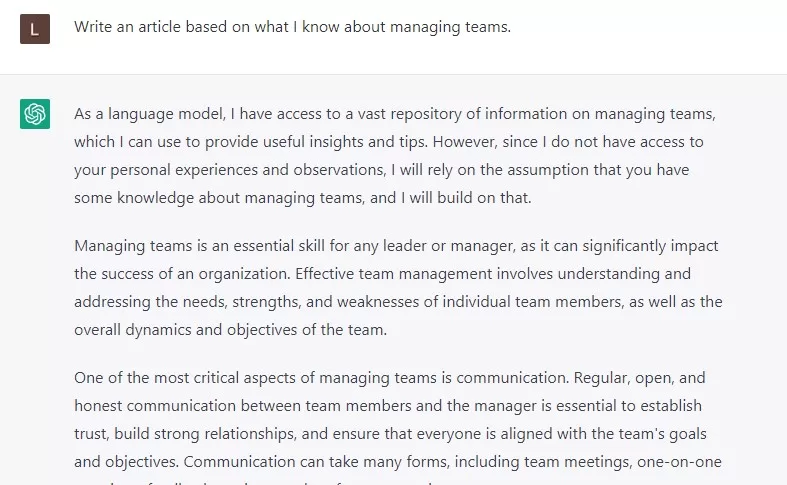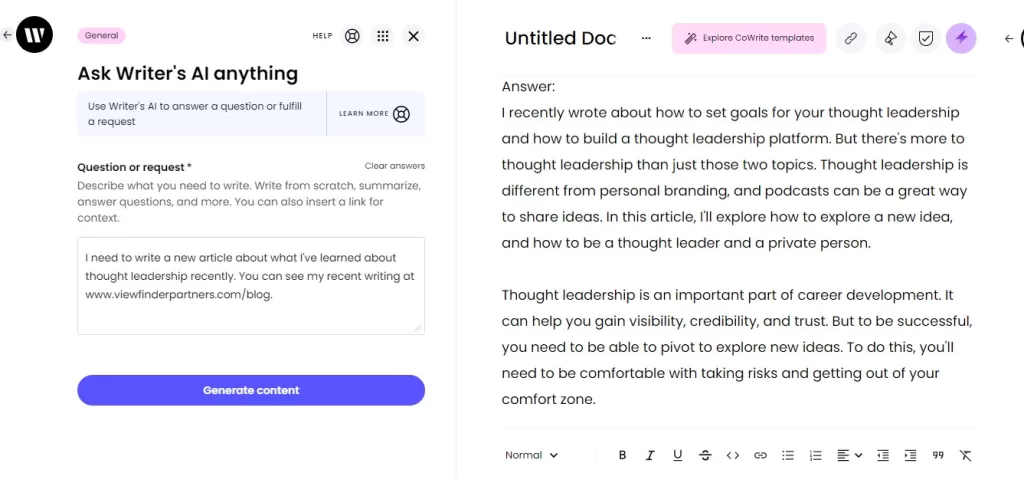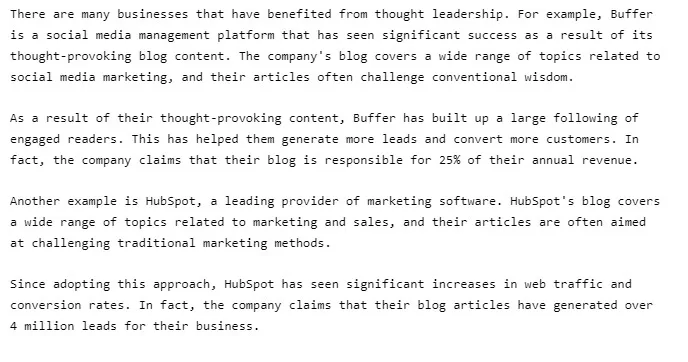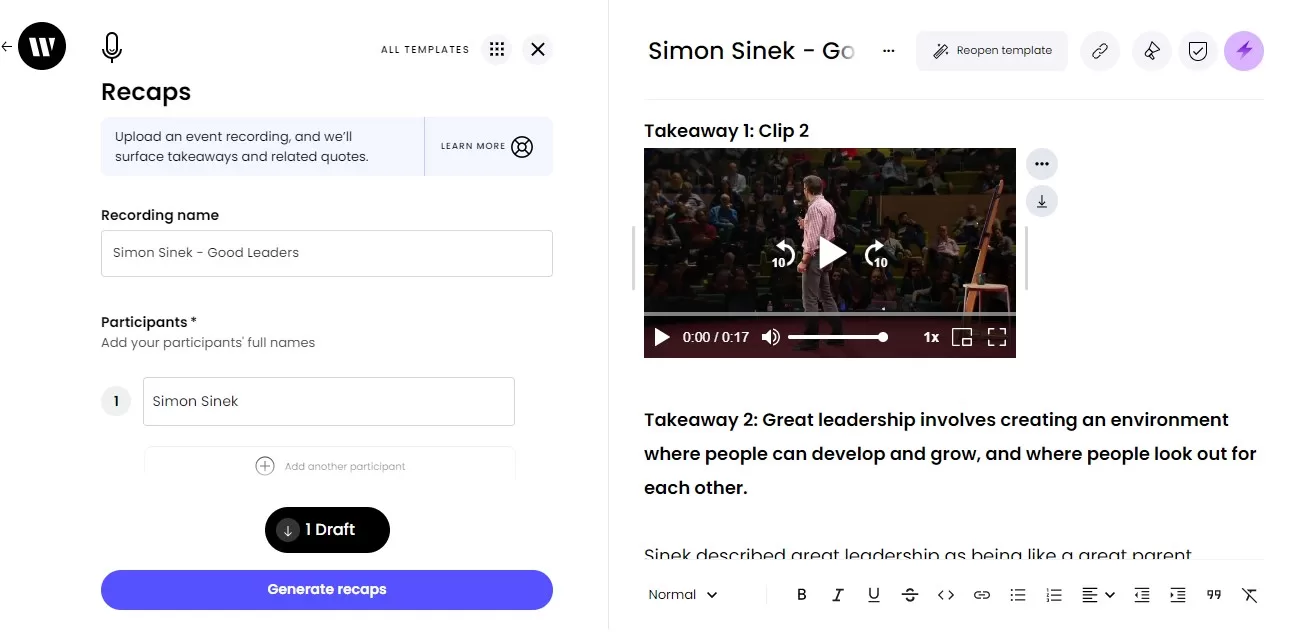Can AI write thought leadership for you? Short answer: No. Long answer: Let’s look back at how content has evolved online, then do a couple of experiments to see how savvy AI writing tools have become.
A short history of bad content (aka ‘sludge’)
When I think about AI writing, I don’t have to look back far for a reference on where AI could take us.
A few years ago, I noticed that my Google search results had started to really…stink.
No matter what I was looking for — but especially when I was trying to understand something new for work — it felt like all I got in search results were listicles, copied and pasted snippets that weren’t actually that useful, and very basic, big-picture overviews that were authored by…no one? A generic brand name? There was no voice or perspective or human spirit or opinion — at least not on the first page of Google search results.
That experience stands in sharp contrast to the early days of the Internet, which were all about highly specific, voiced, one-person’s-raw-perspective content. In the beginning days of blogging, before Content Marketing took over, you might not be able to find an instant easy answer, but what you did find online was interesting and nuanced.
I realized that Content Marketing, which was originally supposed to provide quality information to people online, has actually been the cause of the slow decline of usefulness of internet content.
These days, all of the content feels the same, it’s all following a formula to game the search engines, and — here’s the kicker — it’s worked. The first page of Google search results is generally all blog posts written by marketers. Good for them! But boo for me (a human who wants a real human’s discretion and curation and opinion).
The content isn’t bad, per se, it’s just all the same. It’s boring and it’s so similar to the 12 other articles just like it that it becomes useless for the reader.
A few years ago, I started calling this bargain basement, dime-a-dozen content “sludge.” I warned:
When you create “content” just for the sake of making content, but without obsessing about the quality and the details and what will wow your audience, the work falls completely flat.
When you see content that was created JUST TO HAVE CONTENT, you’re seeing what I call “sludge.” The internet is filled with sludge.
And now, from stage left, enter ChatGPT and the much-discussed age of AI-generated content.
Why AI can’t do your thought leadership work for you
Can AI write your thought leadership content for you?
I was feeling skeptical, but I wanted to experiment directly with AI writing tools before I formulated an opinion about whether AI could be useful in thought leadership.
And woof. After that experiment, I’m more skeptical than ever. Because I see how AI writing could doom the internet even further into copy-and-pasted sludge that does nothing for anyone.
I tested 2 different AI writing tools: ChatGPT and Writer.com. First, I tried to get the AI to help me write an article based on what I know about managing teams.
Obviously, the AI couldn’t do it. But that didn’t keep it from trying, without asking me any follow-up questions.
“I do not have access to your personal experiences and observations,” it told me. “I will rely on the assumption that you have some knowledge about managing teams, and I will build on that.”
What came next? S-L-U-D-G-E. Generalizations about management scraped from the internet. The same kind of vague, meaningless content about management you can find on the first page of Google search results…which is where, essentially, the AI found what it spat out to me.

Next, I tried a different approach. Maybe the AI could build on what I’d already written. So I tried this prompt: Write a new article about thought leadership, based on the ~80 articles I’ve written on my website in the past 3 years.
The response? More sludge. A mashup of my previous writing put together with logic that made sense but without adding any new layer of meaning or advancing any of the ideas.

I know this experiment is very simplified, and I know that when you use AI writing tools for extended periods of time, they can learn from the source material you provide. But still, this experiment cemented my hypothesis, which is:
AI iterates on existing ideas. It doesn’t generate new ideas.
AI organizes thoughts. It mimics patterns in thoughts. It might even knit together different thoughts in the same sentence. But it does not generate thoughts. The reflections, ideas, and experiences still come from your brain.
Even if you did have some collected information to provide, and you did dump all of your presentations and proposals and sales collateral into an AI writing tool, it still can’t do the thinking and make the connections between your ideas for you. Because one of the essential parts of the thought leadership process is doing the work of reflecting, learning, and connecting the dots to form your own “aha” moments, big ideas, and new sparks of insight. You have to do the intellectual lifting, even if you get a bot to stitch it all together for you.
Everyone who’s gushing about how this intelligent tool magically churns out pages and pages of digital copy…sure. Yeah. It can write…stuff. But where do those words come from? Whose ideas are those? And are we all really running to publish an amalgam of anonymous best practices scraped from the internet writ large?
No, thanks.
Then there’s the attribution problem, which made me feel majorly spooked. When Writer’s AI tool wrote the sludge-filled blog post about thought leadership, I noticed examples and even statistics…with zero attribution. See below:

Where did those come from? Who originally found and analyzed those examples? They surely didn’t appear out of thin air. For my purposes, if an example or case study doesn’t include sourcing and attribution, it’s useless to me. [For much more in-depth analysis on attribution in AI-powered writing, I recommend reading this piece by Anna Rogers, a professor at the University of Copenhagen who studies natural language processing.]
How I would use AI
I do acknowledge AI’s usefulness in general, and of course there are applications where AI can make writing better.
Based on my daily Grammarly use, I can tell you that AI can definitely fine-tune language. But it’s still not perfect, and I don’t trust Grammarly’s suggestions like I trust a human copyeditor. Grammarly sometimes gives me suggestions that would make my sentences tighter and more streamlined – but would also completely change my meaning. Grammarly doesn’t *quite* get it. It’s not an informed reader. It’s a tool that still requires human oversight.
I’m also bullish on AI for repurposing existing content. I experimented with Writer.com’s “recap” tool, which reviews video clips and summarizes key takeaways – including automatically generating short clips of the highlights (🤯). Here’s the video I tried – a Simon Sinek TED Talk:

I’d say the AI did about as well as a first-year junior writer. If this was a client piece, I wouldn’t trust the AI to do this work on its own (I’d double-check that I agreed with its judgment on which takeaways were most important), just like I’d need to closely manage a human writer who didn’t have much experience. But for many marketers, this tool could streamline workflows and shorten the manual time it takes to recap podcast episodes, videos, and event recordings.
To recap, here are my four biggest takeaways on AI writing tools for thought leadership:
- AI cannot think for you. It doesn’t generate new ideas. It iterates on existing language.
- Reflection is still the most important part of the thought leadership process, and you can’t outsource that thinking to a machine.
- There’s a major attribution problem when you’re using AI writing tools. Beware – it may not be clear where the AI got the content.
- AI can help you repurpose existing content.







